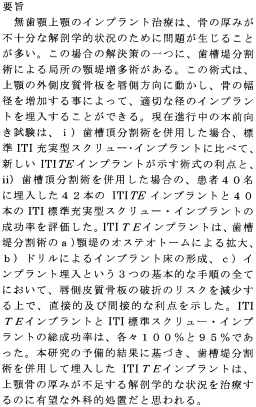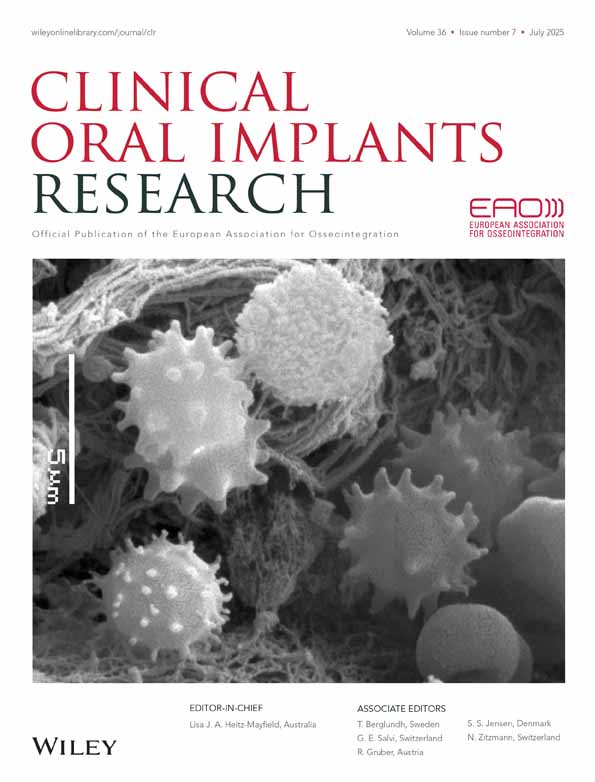Surgical advantages with ITI TE® implants placement in conjunction with split crest technique
18-month results of an ongoing prospective study
Abstract
enAbstract: Implant rehabilitation of the edentulous maxilla may be somewhat problematic because of anatomic situations involving insufficient bone thickness. One approach in this situation is localized ridge augmentation with the split crest technique. This surgical approach allows the external cortical plate of the maxilla to be moved in a labial direction to gain an increase in width to introduce implants of appropriate diameter. This ongoing prospective study evaluated: (i) the surgical advantages that the new ITI TE® implants have showed compared with the ITI standard solid-screw implants when placed in conjunction with the split crest technique and (ii) the implant success rate associated with 42 ITI TE® implants and 40 ITI standard solid-screw implants placed in 40 patients in conjunction with the split crest technique. ITI TE® implants have shown direct and indirect advantages in reducing the risk of fracture of the labial cortical plate during all the three fundamental surgical steps of this technique: (a) the ridge expansion with osteotomes; (b) implant site preparation with drills and (c) implant insertion. The overall success rates of ITI TE® implants and standard screw implants were 100% and 95%, respectively. Based on the preliminary results of the present study, it can be concluded that ITI TE® implants inserted in conjunction with split crest technique seem to be a promising surgical procedure to treat selected anatomic situations involving insufficient maxillary bone thickness.
Résumé
frLa réhabilitation implantaire du maxillaire édenté peut être problèmatique à cause des situations anatomiques comportant une insuffisance de l'épaisseur osseuse. Une approche de cette situation est d'effectuer un épaississement du rebord localisé avec la technique du rebord osseux fendu. Cette approche chirurgicale permet au plateau cortical externe du maxillaire d'être déplacé en une direction linguale pour augmenter la largeur afin de pouvoir ensuite placer des implants d'un diamètre approprié. Cette étude prospective encore en cours a évalué 1) les avantages chirurgicaux des nouveaux implants ITI TE comparés aux implants ITI en vis solide ITI standard lorsqu'ils étaient placés en association avec cette technique de rebord osseux fendu et 2) le taux de succès implantaire associé avec 42 implants ITI TE et 40 implants vis solides ITI standard placés chez 40 patients en association avec cette technique de rebord osseux fendu. Les implants ITI TE ont montré des avantages directs et indirects en réduisant le risque de fracture de la corticale linguale durant les trois étapes chirurgicales fondamentales de cette technique : a) l'expansion du rebord alvéolaire avec les ostétomes, b) la préparation des sites implantaires avec les forets et c) l'insertion implantaire. Les taux de succès généraux des implants ITI TE et des implants vis standards étaient respectivement de 100 % et 95%. Basé sur le résultat préléminaire de cette étude, il peut être conclu que les implants ITI TE insérés en association avec la technique du rebord osseux fendu semble être un processus chirurgical prometteur pour traiter des situations anatomiques sélectionnées qui comportent une épaisseur osseuse insuffisante du maxillaire.
Zusammenfassung
deDie Rekonstruktion einer zahnlosen Situation im Oberkiefer ist dann etwas problematischer, wenn anatomisch ungünstige Gegebenheiten wie zum Beispiel eine ungenügende vertikale Breite des Alveolarknochens besteht. Eine mögliche Vorgehensweise in dieser Situation ist die lokale Knochenaugmentation mittels Spaltung und Spreizung der Knochenkortikalis. Diese chirurgische Methode erlaubt uns, die äussere Kortikalis des Oberkiefers in labialer Richtung abzuspreizen und somit ein genügend breites Knochenbett zu erhalten, um Implantate mit dem geeigneten Durchmesser setzen zu können. Diese noch weiterverfolgte Langzeitstudie untersuchte: (i) die chirurgischen Vorteile, die uns das neue ITI TE-Implantat verglichen mit der Vollschraube des ITI-Standardimplantates in Verbindung mit der Kortikalisspreiztechnik bringt und (ii) die Implantaterfolgsrate von 42 ITI TE-Implantaten und 40 Vollschrauben der ITI-Standartimplantate, die man bei 40 Patienten in Verbindung mit der Kortikalisspreiztechnik gesetzt hat. Die ITI TE-Implantate zeigten direkte und indirekte Vorteile bei der Verminderung des Frakturrisikos in der labialen Kortikalisplatte während den drei grundlegenden Schritten dieser Technik: (a) Spreizung des Knochenkamms mit Osteotomen; (b) Vorbohren des Implantatbettes und (c) Eindrehen der Implantate. Die Erfolgsrate lag bei den ITI TE-Implantaten bei 100% und bei den Standartschraubenimplantaten bei 95%. Basierend auf diesen ersten Resultaten der Studie kann man schliessen, dass es sich bei ITI TE-Implantate, die in Verbindung mit der Kortikalisspreiztechnik eingesetzt worden waren, um eine vielversprechende chirugische Technik handelt, um ausgewählte anatomische Situationen, wie zu Beispiel eine ungenügende vertikale Breite des Alveolarknochens im Oberkiefer, zu behandeln.
Resumen
esLa rehabilitación con implantes del maxilar edéntulo puede ser un tanto problemática debido a situaciones anatómicas que comprenden situaciones de grosor óseo insuficiente. Un enfoque en esta situación, es el aumento localizado de la cresta con la técnica de cresta dividida. Este enfoque quirúrgico permite mover la placa cortical externa del maxilar en dirección labial para ganar un aumento en anchura para introducir implantes del diámetro apropiado. Este estudio prospectivo continuado evaluó: i) los avances quirúrgicos que los nuevos implantes ITI TE han mostrado en comparación con los implantes macizos roscados ITI estándar al colocarse en combinación con la técnica de cresta dividida y ii) el índice de éxito del implante asociado con 42 implantes ITI TE y 40 implantes macizos roscados estándar colocados en 40 pacientes en combinación con la técnica de cresta dividida. Los implantes ITI TE han mostrado ventajas directas e indirectas en reducir el riesgo de fractura de la placa cortical labial durante los tres pasos quirúrgicos fundamentales de esta técnica: a) expansión de la cresta con osteotomos; b) preparación del lecho implantario con fresas y c) inserción del implante. El índice total de éxito de los implantes ITI TE y de los implantes estándar roscados fue del 100% y del 95% respectivamente. Basado en los resultados preliminares del presente estudio, se puede concluir que los implantes ITI TE insertados en combinación con la técnica de cresta dividida parece ser un procedimiento quirúrgico prometedor para tratar situaciones anatómicas determinadas que conllevan un grosor óseo maxilar insuficiente.





